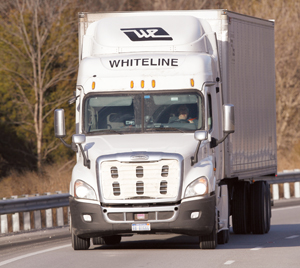Truckload Driver Pay to Rise for Years, Executives, Analysts Forecast
 John Sommers/Transport Topics
John Sommers/Transport TopicsThis story appears in the Feb. 23 print edition of Transport Topics.
CORAL GABLES, Fla. — The accelerating pace and amount of truckload driver pay increases during 2014 will show no letup this year, and probably beyond, industry executives and experts predict.
“We believe we need to get to the $55,000 to $60,000 [annual pay] range,” said Richard Stocking, president of Swift Transportation, which ranks No. 6 on the Transport Topics Top 100 list of the largest U.S. and Canadian for-hire carriers. “We will raise pay this year and next and maybe after that.”
After the carrier’s highest-ever wage increases last year, it will take three to four years to reach that level, Stocking said. He spoke at the BB&T Capital Markets transportation conference here earlier this month.
“The wage increase helped to attract drivers” to Swift’s driving academies, which are full, Stocking said. Wage increases also sparked a decline in Swift’s turnover, which now is about 30% below the industry average.
At Knight Transportation, No. 31 on the for-hire TT100, it took several rounds of pay increases to attract enough drivers to boost its fleet size, excluding acquisitions.
“It was all we could do last year to get 5% more drivers,” CEO David Jackson said. “We have our work cut out for us” to keep growing the fleet.
Knight’s increases were 10%, a level that’s expected to continue, he said.
Double-digit increases also were initiated by privately held carriers last year, including Crete Carrier, No. 30 on the for-hire TT100 and No. 18 U.S. Xpress Enterprises.
American Trucking Associations gauged truckload drivers’ annual pay at more than $46,000 in its driver compensation survey.
“Like the third quarter, the fourth quarter was unusually active for pay changes,” Gordon Klemp, principal at the National Transportation Institute, told TT on Feb. 19.
Last quarter, 19% of fleets said they would raise pay, trailing the record 42% in the third quarter, which was more than triple the prior record.
Klemp also said pay is rising for local and intermodal drivers because of hiring challenges, putting more pressure on the typically higher pay rates for regional and over-the-road operators.
“All fleets believe that they’ll need to duplicate the larger driver-pay increases, not only again in 2015 but likely again in 2016 and 2017,” Thom Albrecht, an analyst at BB&T, wrote in a report.
David Parker, CEO of No. 43 Covenant Transportation Group, illustrated the challenge that fleets face.
He recounted the question he asks every time he speaks to a group: “How many of you are telling your kids or grandkids — have you considered driving a truck?”
Barely 1% answer yes, he said, observing, “No wonder we have a problem.”
Parker predicted driver pay might have to rise to as much as $85,000 from the current low-$50,000 level.
There were some bright spots related to the industry’s Hiring Our Heroes effort as veterans leave the military.
YRC Freight President Darren Hawkins said the company hired 400 ex-military drivers last year and aims to increase that to 1,000 in 2015.
Werner Enterprises, No. 14 on the for-hire TT100, over the past three years has hired more than 5,000 workers who were in the military, President Derek Leathers said.
At Celadon Group Inc., CEO Paul Will outlined the company’s success in boosting its driver corps, with schools that added 500 new drivers.
Without that group, he said, the company would have had a 200-driver reduction.
Will said another strategy that has worked for No. 44 Celadon is acquisition of profitable fleets whose drivers stay with Celadon.
A report from Stifel, Nicolaus & Co., another investment firm, said driver availability should improve slightly this year as pay increases attract some drivers and laid-off oil-field workers return to for-hire trucking.

